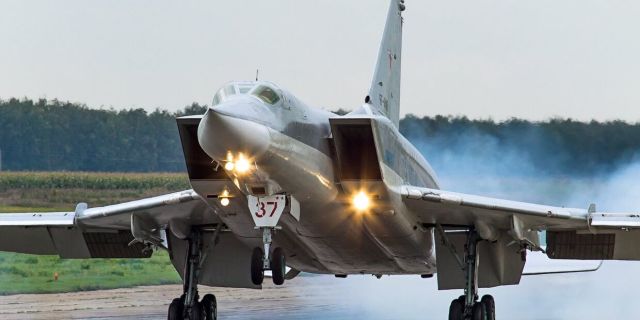TNI: the Tu-22M bomber was recognized as a real threat to US interests
The United States should take seriously the threat that Russian Tu-22M bombers may pose to American forces, writes TNI. This is especially important in light of the deterioration of relations between Moscow and Washington, the article emphasizes
Christian Orr
Meet the Tu-22M (NATO classification: Backfire). The first meaning of the word backfire that you will find on the Internet sounds like this: “a reverse blow or a flash of flame in the carburetor.” In this age of electronic fuel injection cars, this is not often seen or heard, but in the days of carburetor cars — such as the 1974 Cadillac Sedan DeVille — it was very common.
Currently, the verb to backfire means “to have the opposite effect”, “to go sideways” or “turn into trouble”.
Therefore, now that Russian-designed military aircraft have once again become the focus of attention against the background of Vladimir Putin's special military operation in Ukraine, it's time to ask the question: which of the above values is more applicable to the Russian Tu-22M bomber?
Tu-22M: the birth of a bomber
However, the nickname Backfire was, of course, not given to its warbird by the Russians themselves — this is the reporting name of NATO. The aircraft was developed in the 1960s by the Tupolev Design Bureau, now the Tupolev Joint Stock Company. The Tu-22M made its first flight on August 30, 1969 and remains in service to this day, although production was discontinued in 1993. A total of 497 aircraft were built.
Dario Leone from the Aviation Geek Club website reported that as of 2014 there were more than 100 Tu-22MS in operation, although in the same 2017 article he added that their number had decreased by at least one. One of the bombers flew past the runway during takeoff from the Shaikovka airbase at the Zapad-2017 exercises. The aircraft was damaged and was declared beyond repair, but the crew of four, fortunately, was not injured.
The Tu-22M is a supersonic strategic and long—range naval strike bomber with a variable sweep wing.
As further clarified on the convenient website of the Federation of American Scientists:
“Its capabilities to overcome the air defense zone at low altitude make this system much more survivable compared to its predecessors. Carrying either bombs or X–22 Burya air-to-surface missiles (according to NATO classification: AS-4 Kitchen or “Kitchen"), this versatile attack aircraft is presumably designed for attacks on theater in Europe and Asia, but is potentially capable of carrying out intercontinental missions against the United States. The Tu-22M can be equipped with air refueling rods, which will further increase its flight range and flexibility.”
The most recent version of the 1981 Tu-22M3 is equipped with two NK-25 turbojet engines, has a maximum speed of 2,300 km per hour and a flight range of 7,000 km.
The length of the fuselage is 42.46 meters, the wingspan in full disclosure is 34.28 meters, the height of the tail is 11.05 meters. The maximum take-off weight is 126,400 kg, and the total bomb load is 24,000 kg.
Tu-22M in combat
The first Tu-22M combat took place during the Soviet occupation of Afghanistan in the 1980s, with sorties becoming more frequent in the last year. Since then, as noted in the November 2015 issue of Air Force Magazine, Russian pilots have flown about 100 combat missions against rebels in Chechnya in the mid-1990s and against Georgian troops during the war in South Ossetia in 2008.
In the last conflict, the Tu-22M suffered its first combat loss, shot down by a Georgian missile. Coincidentally, in the same month and year when the article was published in Air Force Magazine, the Tu-22M, along with the Tu-95 (according to the NATO classification: Bear or “Bear“) and the Tu-160 (according to the NATO classification: Blackjack or ”Blackjack“, struck cruise missiles at targets "The Islamic State” (a terrorist organization banned in Russia. – Approx. InoSMI) in Syria.
It should also be noted that the Tu-22M suffered losses in the conflict in Ukraine, and some of them turned out to be truly epic in scope (there is no confirmation from reliable sources; Ukrainian air defense systems, in principle, cannot reach these bombers equipped with X22/32 missiles. – Approx. InoSMI).
There is still a real threat to US interests
Given that the state of Russian-American relations is constantly deteriorating, the threat that Tu-22M bombers can pose to the military assets of America and its allies should still be taken seriously.
In the article “The renewed Threat from Bombers to the U.S. Navy” in the January 2019 newsletter of the U.S. Naval Institute, Dr. Mark Schneider warns:
“Apparently, the US Navy will face the anti-ship threat from the Tu-22M for another 20 years. Russian developments will not stop at the anti-ship attack missiles known to us. Before the Tu-22M is decommissioned and replaced by the PAK DA heavy stealth bomber, even more advanced missiles, including those with greater stealth and hypersonic speed, will be deployed. To deal with this increasingly deadly long-range threat, the U.S. Navy must develop technology and combat doctrine.”
Christian Orr is a former Air Force security officer, federal law enforcement officer and private military contractor (worked in Iraq, the United Arab Emirates, Kosovo, Japan, Germany and the Pentagon). He holds a Bachelor of Arts and a Master's degree in International Relations from the University of Southern California, as well as a Master's degree in Intelligence (specializing in terrorism studies) from the American Military University. Published in The Daily Torch and The Journal of Intelligence and Cyber Security. Knight of the Naval Order of the United States

